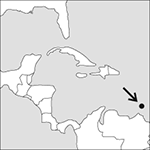
Source: MAPS IN MINUTES™ © RH Publications (1997)
Capital:
St George’s
Area:
344 sq km (133 sq miles)
Population:
109,590 (2013 est)
Currency:
1 East Caribbean dollar=100 cents
Religions:
Roman Catholic 53.0%; Anglican 13.8%; other Protestant 33.2%
Ethnic Groups:
Black 82.0%; mixed 13.0%; European and East Indian 5.0%
Languages:
English (official)
International Organizations:
UN; OAS; CARICOM; Commonwealth; Non-Aligned Movement; WTO
A state comprising the southernmost of the Windward Islands in the Caribbean and several small islands, part of the Grenadines archipelago.
Physical
The island of Grenada contains rugged and forested mountains, rising to Mount Saint Catherine at 838 m (2749 feet), with crater lakes and springs. The mountains are of volcanic origin and enclose valleys where bananas, spices, and sugar cane are grown.
Economy
Tourism is Grenada’s main earner of foreign exchange. The principal exports are agricultural products: nutmeg, bananas, cocoa, and fruit and vegetables. Industries include food and drink and textiles; an offshore finance sector is developing. Tourism and agriculture both suffered severely from hurricanes in 2004–05, and reconstruction has left a large legacy of debt. In 2018 significant offshore oil and gas reserves were found.
History
Grenada was discovered by Columbus in 1498. Colonized by the French governor of Martinique in 1650, it passed to the control of the French crown in 1674. The island was conquered by the British during the Seven Years War and ceded to them by the Treaty of Paris (1763). An uprising in 1795 against British rule, supported by many slaves, was put down the following year, and Grenada remained a British colony for almost two centuries. Universal adult suffrage was granted in 1950 when the United Labour Party, led by Matthew Gairy, emerged. The Windward Islands were granted self-government in 1956 and became a member of the West Indies Federation (1958–62). Following the break-up of the federation, the various Windward Islands sought separate independence. This was gained by Grenada in 1974, when Gairy became Prime Minister. He was deposed in a bloodless coup (1979) by Maurice Bishop (1944–83), leader of a left-wing group, the New Jewel Movement, who proclaimed the People’s Revolutionary Government (PRG). He encouraged closer relations with Cuba and the Soviet Union but, following a quarrel within the PRG, he was overthrown and killed by army troops led by General Austin in 1983. Military intervention by the USA prevented a Marxist revolutionary council from taking power. US troops left the island in December 1983, after democratic government was re-established. Under Prime Minister Herbert Blaise (1984–89) political stability was restored. By the end of the decade, however, difficulties with the economy led to an IMF austerity programme. In June 1995 a general election brought the New National Party (NNP) to power under Prime Minister Keith Mitchell. It was re-elected in 1999 and 2003 but defeated in 2008 by the New Democratic Congress. Mitchell and the NNP returned to power in 2013 and were re-elected in 2018.
- Galois, Evariste
- Galois field
- Galois group
- Galois, Évariste (1811–32)
- GALP
- GALT
- Galton, Francis (1822–1911)
- Galton, Sir Francis
- Galton, Sir Francis (1822–1911)
- Galton–Watson model
- galvanic cell
- Galvani, Luigi
- Galvani, Luigi (1737–98)
- galvanization
- galvanized iron
- galvanomagnetic effect
- galvanometer
- galvanometer constant
- Galápagos finches
- Galápagos Rift
- Galápagos Rise
- GAM
- Gambia, the
- Gamble, Josias Christopher
- gambler's fallacy